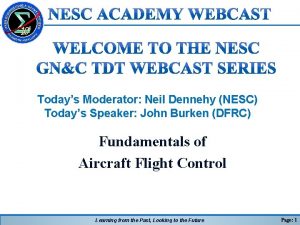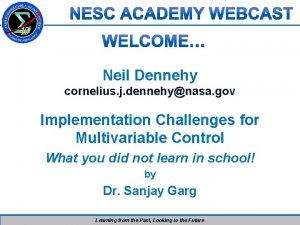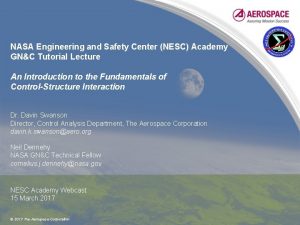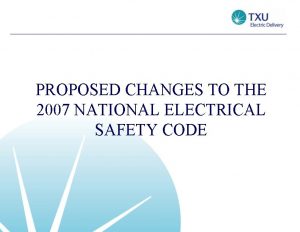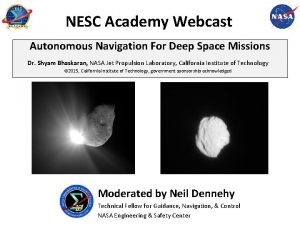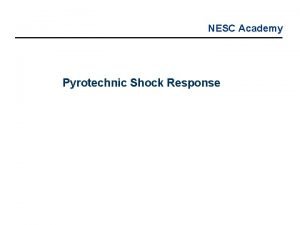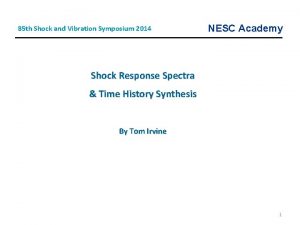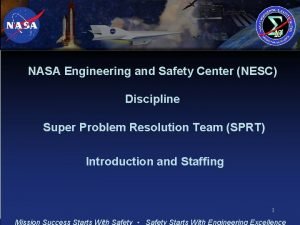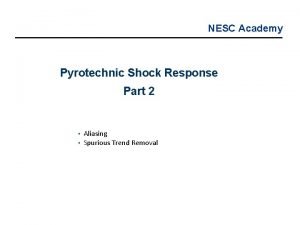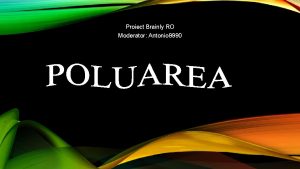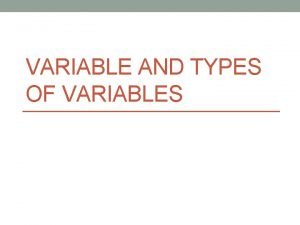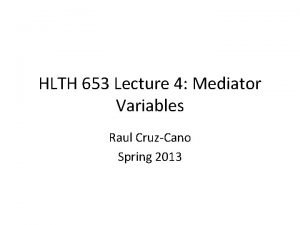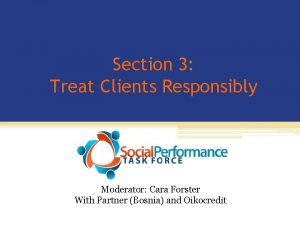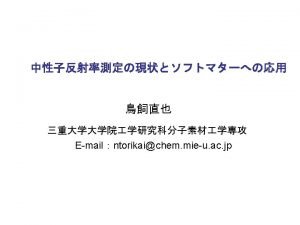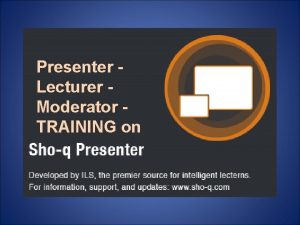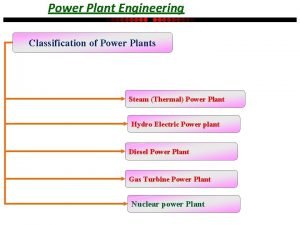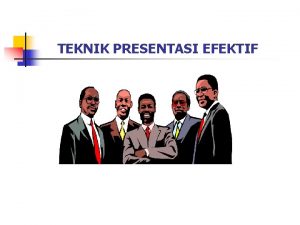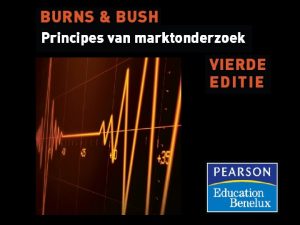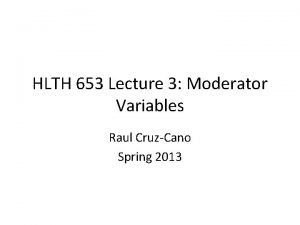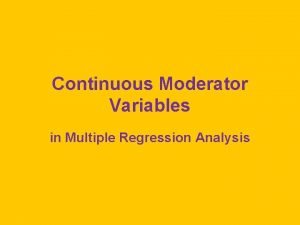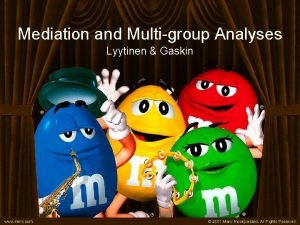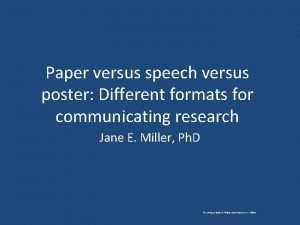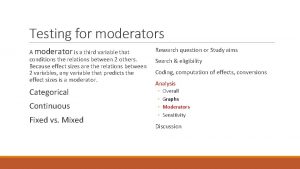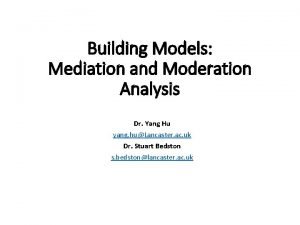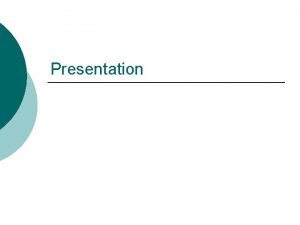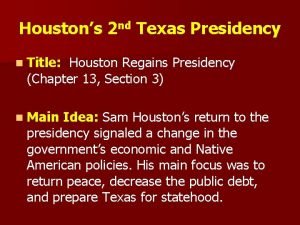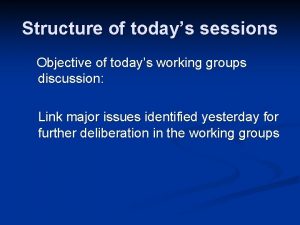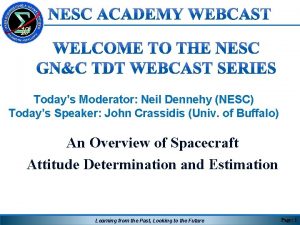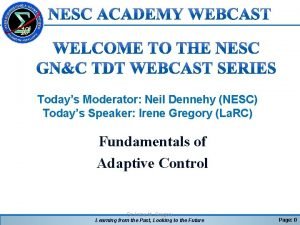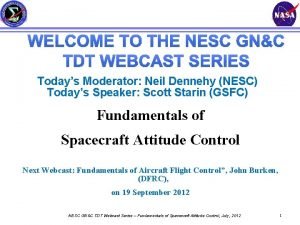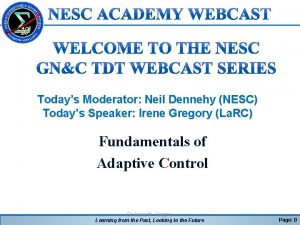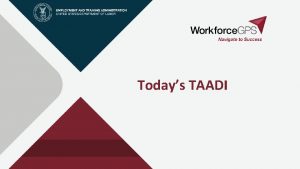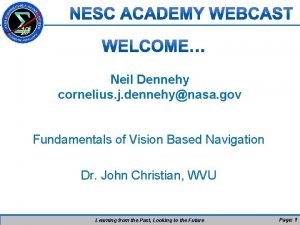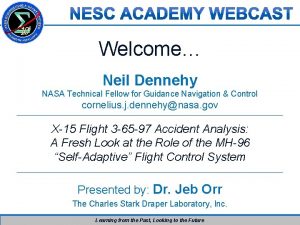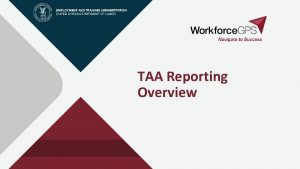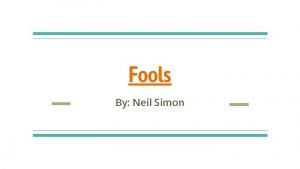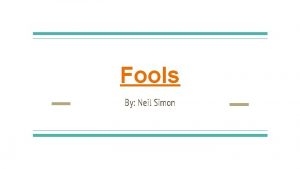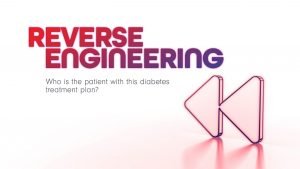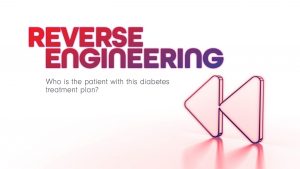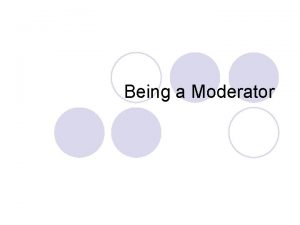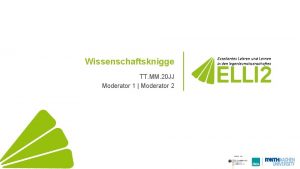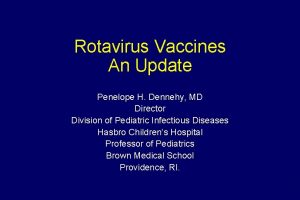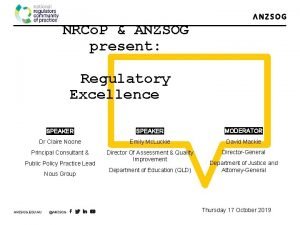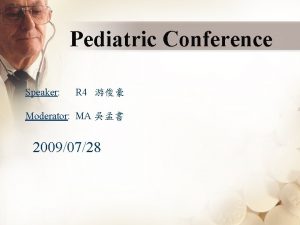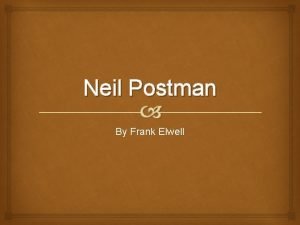Todays Moderator Neil Dennehy NESC Todays Speaker John



































- Slides: 35

Today’s Moderator: Neil Dennehy (NESC) Today’s Speaker: John Burken (DFRC) Fundamentals of Aircraft Flight Control Learning from the Past, Looking to the Future Page: 1

Learning from the Past, Looking to the Future

NASA Engineering and Safety Center (NESC) Webcast Fundamentals of Aircraft Flight Control NESC GN&C Webcast October 17, 2012 John Burken NASA DFRC NESC Technical Discipline Team Member 3

Outline Objective of Talk § Why use control − Some Under Graduate Background Information − What’s not covered due to time constraints § Models − X-29 example § Design Method Used − Background on Robust Servomechanism LQR (LQI) § Robustness Issues − Add actuators with surface and rate limits − Sensors (real states or estimated states? ) § Results / Time Histories § Conclusions − Remarks § Appendix − Call me for models and matlab files 4

Flight Control Design – a snap shot Objective of Talk: § This 50 minute “short course” will hopefully hit the major control design issues and what to beware of in the “design process”. § In a linear design world the actuator rates and limits are ignored, along with time delays, and this can bring down an otherwise “good design method”. § This class will hopefully show you ways to design a robust control design method with some of the “real world” issues involved. § The control method will be the Linear Quadratic Tracker design technique, applied to the X-29 vehicle with matlab scripts included upon request. § Scripts available for self-study purposes. − Call or email john. burken@nasa. gov 661 -276 -3726 § Why the X-29 Models are open literature (no ITAR or SBU issues) Therefore we can show them, design with them & give them out. 5

Flight Control Design – Not covered § Not Covered in this Talk but are important: (maybe covered in later talks? ) − Software and hardware System redundancy {triplex etc…} − Verification and validation testing {did you design it the way you wanted & does it make sense} − System Failure Accommodation {one engine out etc…} − Pilot / Aircraft Handling Qualities (one bad pilot rating can cause a full redesign cycle) − Aero. Servo. Elasticity (ASE) When flexible structures meets dynamic pressure − Integrator Windup Protection − Digital system design (some talk on anti-aliasing) 6

Basic review of concepts (Under Graduate stuff) § 7

Basic review of concepts (continued) § 8

Flight Controllers § Typical Controller types: − Stability Augmentation Systems (SAS) • Purpose: Increase damping / very simple • Pitch, Roll & Yaw Dampers Actuator model pilot stick • Limited control authority • Limited number of sensors required q (d/s) − Command Augmentation Systems (CAS) • Purpose: Track pilots commanded inputs A/C response • _cmd , _cmd or p_cmd etc… • Autopilots • Help reduce pilot work load • Altitude hold, Mach hold ; etc… Pilot cmd K(s) G(s) sensors 9

Feedback in a Nutshell e = r-y r u k y G § Objective is to make the error e small − But don’t know G exactly. − Use feedback and make k large to make e small − Larger k can give better performance − Large k is good for disturbance rejection − Large k can give rate limiting etc… − Large k is bad for noise rejection 10

Assuming we have stability! § Too little feedback won’t stabilize an unstable G § Too much feedback can destabilize a stable G § Controller tuning by trial and error can be dangerous: cliffs are conceivably everywhere? Do you want to chance this? ? 11

Continuous (s-plane) to discrete (z-plane) § A word of caution if you have a digital system (and who doesn’t these days? ) − Aliasing • High frequency signals are “aliased” into lower frequencies. • Just see a movie with a stagecoach wheel as it starts to turn faster!!! − Sampling theorem : Critical frequency • /T Nyquist frequency − Don’t let the high frequencies look like low frequencies. • The fix: Use a Continuous low pass filter, F(s) on all signals used in the digital controller • Look up anti-aliasing filters • Anti-aliasing filter: “Don’t leave home without one” 12

All models are wrong, but some are very useful § The model must suit the task − Balance simplicity and accuracy − Accommodate uncertainty § Most models are based on a combination of physics and data − Physics: Newton, Maxwell, Hooke, Joule − Data: Measurements and the estimates we derive from them • Parameters, frequency response, empirical models § Moral of the story: Don’t assume your model is right, you need to build in robustness 13

1 st Fundamental Question of Control Tuning What limits feedback performance? Performance is the ability to stabilize, follow commands, and reject disturbances 14

What Makes Feedback Control Challenging? − Unstable and lightly damped dynamics (requires stabilization) − Noise (sensor, actuator, disturbance) − Non-minimum-phase zeros (limits achievable performance) − Time delays − Loop coupling (MIMO) • (ex yaw into roll, use a little rudder and see what happens open loop) − Nonlinearities • Nonlinear dynamics (geometric, kinematic, chaotic, …) • Hardware constraints (magnitude/rate saturation, deadzone) − Constraints on states (hard bounds) − Model uncertainty • Exacerbates all of the above 15

2 nd Fundamental Question of Feedback Control What do you need to model and how accurately do you need to model it? • Remember all models are wrong. • You need robustness to uncertainties • For SISO systems use phase “and/or” gain margins • For MIMO use analysis 16

Gain and Phase Margins -GM +GM Im Im -1 Re -1 +PM +GM Close to (-1, j 0). Small simultaneous gain and phase uncertainty will destabilize closed loop system. Gain Margins: Re +PM Phase Margins: Include These Models In Frequency Domain Analysis Command Inputs Controller Plant Input Time Delay Zero Order Hold Actuator Dynamics Rigid Body Dynamics lin. . . timedelay zoh actuate lon lat/dir + + ASE Dynamics Linear Analysis Model TBD ASE Compensation asecomp Plant Output Time Delay timedelay Sensor Dynamics C FB sensor 17

Important Transfer Function Loops SISO Returned Signal + - Inject signal Injected Signal K(s) G(s) Controller Plant , examine returned signal K(s), G(s) Transfer Functions - The Return Difference Dynamics Zeros of the return difference are the poles of the closed loop system Sensitivity Complementary Sensitivity 18

Recap § You need a controller (open loop response is not good)? − Will SAS work or do you need full CAS − Will a linear controller work? § Is the controller Single Input Single Output (SISO)? − Classical gain or phase margins (anywhere in the loop: same margins) § Is the controller Multiple Input Multiple Output (MIMO)? − Robustness − Use mu (but we still use SISO margins on top of mu – Get pass the FRR). • Why SISO Gm or Pm: Some axes are very decoupled and SISO is almost OK! • Why MIMO Mu: It can be shown (Doyle) that infinite margins in SISO format is no guarantee § Don’t trust your models − All models are wrong, but by how much? § I assumed you have had a root locus design course. − We’ll start off with the cornerstone to modern control design (LQR) 19

Design Example § Design an LQR controller −Why LQR? • Guaranteed Stability Margins for LQRs • Excellent Stability Guarantees { -6, ∞} Gain Margins and {± 60 degree} Phase Marin • Example of LQRs Boeing 777 lateral/directional axes • Small problem with LQRs • Regulators like zero commands • Airplanes don’t fly at zero AOA −You may need the LQR controller to track a constant command • Robust servomechanism RSLQR Tracker LQR-PI LQI • To track a constant command you need a type 1 controller • Append the integrator states to Open Loop dynamics • Examples of LQR trackers • X-31 (The Germans non-zero set point LQR) • JDAM (Boeing) 20

Servomechanism Design Methodology § Optimize the following cost function. Optimal linear-quadratic-regulator (LQR) problem. § The algebraic Riccati equation § And the optimal control is given by: 21

Servomechanism Design Methodology (cont. ) Note : À LQR Servo = LQR PI = LQI (matlab) Á Approach is simple to implement. If this statement is true: there exist a closed-loop system that is stable. 22

Servomechanism Design Methodology (cont. ) § 23

X-29 Lat/Dir Linear Model Flt condition: Mach. 7 / H = 20 k ft Design the controller to track p & b commands 24

X-29 Lateral Directional State Space Models § Flt condition: Mach. 7 / H = 20 k ft Outputs = x’s = [β p r phi] radians Inputs = u’s = [Ailerons Rudder] degrees 25

Block Diagram 26

3 test cases for Mach. 7 // H= 20 k ft § Test case 1: − Design without actuators (not thinking to much about reality) − Does it meet requirements § Test case 2: − Test the first case with real actuators § Test case 3: − Redesign with actuators in mind − Reduce gains to reduce command demand 27

X-29 Lat/Dir LQI Design § Test Case 1: First design without actuators: − Why : If it does meet your requirements here, how can it with real actuators? ? Controller gains Klqi = [-22. 0455 5. 0649 8. 6107 35. 5815 -29. 5533 96. 9614 7. 5731 -47. 7479 -295. 5326 -35. 5815] 28

X-29 Lat/Dir LQI Design § Test Case 2: Test with actuators {same gains} Has states and real limits {rate limits / position limits} Performance? ? Rate limiting? ? Controller gains Klqi = [-22. 0455 5. 0649 8. 6107 35. 5815 -29. 5533 96. 9614 7. 5731 -47. 7479 -295. 5326 -35. 5815] Gains are too BIG!! 29

X-29 Lat/Dir LQI Design § Test Case 3: Change the Q & R weightings to penalize the surface activity (Reduce demand on commands) Controller gains Klqi = [ -12. 4120 5. 5202 3. 7623 7. 4219 -30. 7395 3. 2892 2. 3039 -11. 2919 -43. 4722 -10. 4962] Gains are lower!! 30

Final Remarks − Always design with a reality check in final test (put in real actuators etc. . ). − In your simulation: add realistic time delays and non-linear elements. • Go from simple to more complex (3 dof 6 dof) • Why not just start in nonlinear high fidelity 6 dof simulation? • You lose insight to simple dynamics. − Have the pilot involved early in the 6 -dof simulation. 31

Appreciations / Thanks § Dennis S. Bernstein − Department of Aerospace Engineering, University of Michigan § Kevin A. Wise − Boeing 32

Appendix § If you want the matlab scripts or have questions please call or email me. § If you improve on the example please share with us (NESC). − John Burken • phone 661 -276 -3726 • john. burken@nasa. gov 33

ANY QUESTIONS? Learning from the Past, Looking to the Future Page: 34

Upcoming NESC GN&C TDT Webcasts (as of October 2012) “Fundamentals of Adaptive Control”, Irene Gregory (La. RC), 28 th November 2012, 2 pm Eastern Time (4 th Wednesday of Nov only) “Fundamentals of Spacecraft Attitude Determination”, John Crassidis (Univ. of Buffalo), on 16 January 2013 “Fundamentals of Kalman Filtering and Estimation”, Chris Dsouza (JSC), on 20 March 2013 Learning from the Past, Looking to the Future 20 June 2012 Update
 Neil dennehy
Neil dennehy Neil dennehy
Neil dennehy Moderator speaker
Moderator speaker Gillian dennehy
Gillian dennehy George dennehy
George dennehy Nasa nesc academy
Nasa nesc academy Nesc rule 250c
Nesc rule 250c Nokia nesc
Nokia nesc Nesc academy
Nesc academy Frangible joint
Frangible joint Shock and vibe symposium
Shock and vibe symposium Nasa engineering and safety center location
Nasa engineering and safety center location Nesc academy
Nesc academy Ce este solubilitatea brainly
Ce este solubilitatea brainly What is control variable in research
What is control variable in research Modern standby
Modern standby Mediation examples
Mediation examples Cara moderator
Cara moderator Constant moderator
Constant moderator Moderator show
Moderator show Difference between moderator and control rods
Difference between moderator and control rods Tugas moderator adalah
Tugas moderator adalah Kwalitatieve observatie
Kwalitatieve observatie Moderator examples
Moderator examples Continuous moderator
Continuous moderator Dm80 moderator
Dm80 moderator Moderator examples
Moderator examples What is a difference between the speech and the poster
What is a difference between the speech and the poster Moderator
Moderator Mediator vs moderator
Mediator vs moderator Assalamualaikum & good morning
Assalamualaikum & good morning Moderatör
Moderatör Moderator
Moderator Moderator tom
Moderator tom Date frui
Date frui Todays objective
Todays objective
